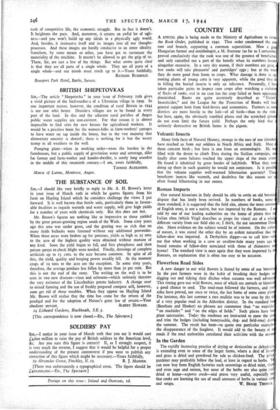THE SUBSTANCE OF SOIL
SIR,—I should like very briefly to reply to Mr. A. H. Brown's letter in your issue of March loth in which he quotes figures from his farm on Hayling Island which he considers challenge the views I put forward. It is well known that fertile soils, particularly those in favour- able localities as regards warmth and water supply, will give high yields for a number of years with chemicals only. But this does not last. Mr. Brown's figures are nothing like so impressive as those yielded by the great potato-growing region south of the Wash. Some sixty years ago this area was under grass, said the grazing was so rich that on many fields bullocks were fattened' without any additional provender. When these areas were broken up for potatoes, yields as high as 25 tons to the acre of the highest quality were obtained without manure of any kind. Soon the yield began to fall, and first phosphates and then poison sprays to check blight were needed. Finally, dressings of complete artificials up to 15 cwts. to the acre became common. In spite of all this, the yield, quality and keeping power steadily fell. At the moment crops of 12 tons to the acre are the exception. In some sixty years, therefore, the average produce has fallen by more than 5o per cent. But this is not the end of the story. The writing on the wall is to be seen in two new diseases—virus and eelworm—which seriously threaten the very existence of the Lincolnshire potato industry. A change over to mixed farming and the use of freshly prepared compost will, however, soon get rid of these troubles. When they appear on Hayling Island Mr. Brown will realise that the time has come for the return of the prodigal and for the adoption of Nature's great law of return.—Your obedient servant, ALBERT HOWARD. 14 Liskeard Gardens, Blackheath, S.E. 3.
[This correspondence is now closed.—ED., The Spectator.]


























 Previous page
Previous page